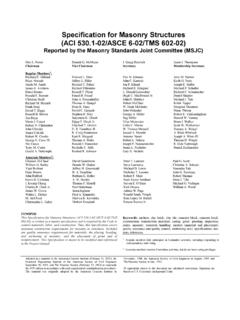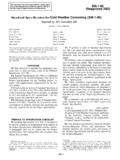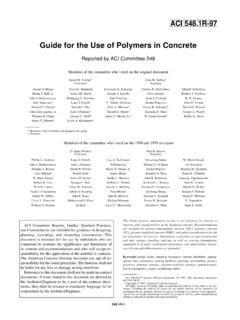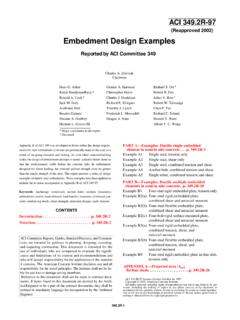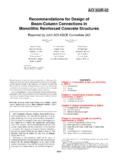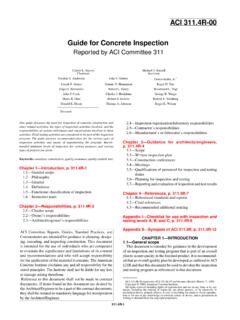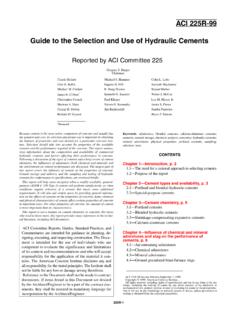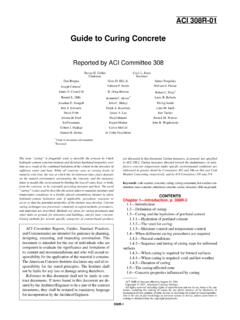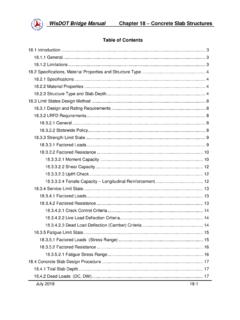Transcription of 357R-84 Guide for the Design and Construction of …
1 ACI 357R-84 . (Reapproved 1997). Guide for the Design and Construction of Fixed Offshore Concrete Structures Reported by ACI Committee 357. Harvey H. Haynes, chairman Fiorato, secretary A. Leon Abolitz George F Davenport William A. lngraham Charles E. Smith Arthur R. Anderson Joseph A. Dobrowolski Richard W. Litton Raymond J. Smith Jal N. Birdy Duncan Alan H. Mattock Stanley G. Stiansen Irvin Boaz Svein Fjeld Karl H. Runge Alfred A. Yee Anthony D. Boyd Ben C. Gerwick, Jr. Malcolm Sharples Shu-Yin Yu William J. Cichanski Associate Members Nicholas Carino Odd E. Gjerv Masatane Kokubu Monnier John Clarke Eivind Hognestad W. Frank Manning The report provides a Guide for the Design and construc- Chapter 2-Materials and durability, page 357R-3. tion of fixed reinforced andlor prestressed concrete struc- cover of tures for service in a marine environment.
2 Only fixed struc- reinforcement tures which are founded on the seabed and obtain their control of reinforcement stability from the vertical forces of gravity are covered. and chemical damage Contents include: materials and durability; dead, defor- water of prestressed mation, live, environmental, and accidental loads; Design anchorages and analysis; foundations; Construction and installation; 2. g-concrete for embedments and inspection and repair. Two appendixes discuss environ- and connections to steel work mental loads such as wave, wind, and ice loads in detail, and and ground prestressing steel of pipes containing the Design of offshore concrete structures for earthquake ducts pressure resistance. resins Keywords: anchorage (structural); concrete Construction ; Construction Chapter 3-Loads, page 357R-6. materials; cracking (fracturing); dynamic loads; earthquakes; earthquake re- sistant structures; foundations; grouting; harbor structures; inspection; phases loads (forces); ocean bottom; offshore structures; post-tensioning; pre- stressed concrete; prestressing steels; reinforced concrete; repairs; static loads; structural analysis; structural Design ; underwater Construction .
3 Chapter 4- Design and analysis, page 357R-6. requirements strength requirements analysis CONTENTS conditions Preface, page 357R-2. Chapter 5-Foundations, page 357R-10. Notation, page 357R-2 -Site investigation of the sea floor of mat foundations Chapter 1-General, page 357R-2. -scope systems and Chapter 6- Construction , installation, and interfaces relocation, page 357R-12. ACI Committee Reports, Guides, Standard Practices, and Commen- taries are intended for guidance in designing, planning, executing, or inspecting Construction and in preparing specifications. Reference to Supersedes ACI 357-78 (Reaffirmed 1982). these documents shall not be made in the Project Documents. If items Copyright 0 1984, American Concrete Institute. All rights reserved including rights of reproduction and use in any form or by any means, including the making of copies found in these documents are desired to be part of the Project Docu- by any photo process, or by any electronic or mechanical device, printed or written or ments, they should be phrased in mandatory language and incorpo- oral, or recording for sound or visual reproduction or for use in any knowledge or re- rated into the Project Documents.
4 Trieval system or device, unless permission in writing is obtained from the copyright proprietors. 357R-1. 357R-2 ACI COMMITTEE REPORT. General Construction while afloat or NOTATION. Buoyancy and floating temporarily grounded stability Towing A = accidental load Construction joints Installation cm = hydrodynamic coefficient Concreting in hot or Construction on site D = dead load, diameter of structural member cold weather Connection of adjoining structures E = environmental load Curing of concrete Reinforcement Prevention of damage EC = concrete modulus of elasticity due to freezing = initial modulus of elasticity Prestressing tendons, Ei Relocation ducts, and grouting Eo = frequently occurring environmental load Initial flotation EImu = extreme environmental load Chapter 7- lnspectlon and repair, page 357R-16 4 = reinforcing steel modulus of elasticity L = live load General Repair of concrete Surveys Repairs to cracks LX = maximum live load L,, = minimum live load Chapter References.
5 Page 357R-17 T = deformation load W/C = water-cement ratio Standards-type references b = section width Appendix A-Environmental loads, 4 = diameter of reinforcing bar page 357R-18 = effective tension zone Introduction Dynamic response analysis : = stress in concrete Wave loads Wind loads = allowable Design stress in concrete Wave diffraction Ice loads P = stress in reinforcing bar Currents Earthquakes Design wave analysis References L = allowable Design stress in reinforcing bar Wave response = mean tensile strength of concrete spectrum analysis f = yield stress of reinforcing bars k = 28-day strength of concrete (ACI 318). Appendix B- Design for earthquakes, h = section thickness page 357R-19 X = depth of compression zone Introduction Dynamic analysis YC = material factor for cohesive soils Overall Design Stress analysis = material factor for friction type soils procedure Failure modes Yf Seismicity study Ductility requirements YL = load multiplier Site response study Aseismic Design details Y, = material factor Selection of Design Other factors Y IlK = material factor for concrete Y.
6 Criteria Yms = material factor for reinforcing bars PREFACE A*$ = increase in tensile stress in prestressing steel with reference to the stress at zero strain in the concrete Concrete structures have been used in the North Sea and = strain other offshore areas of the world. With the rapid expansion of i = wave length knowledge of the behavior of concrete structures in the sea, = strength reduction factor and discoveries of hydrocarbons off North American shores, 0. there will likely be an increased use of such structures. This report was developed to provide a Guide for the Design and CHAPTER 1-GENERAL. Construction of fixed offshore concrete structures. Reference to the following documents is acknowledged: API Recommended Practice for Planning, Designing, and Constructing Fixed Offshore Platforms, API RP2A, Ameri- This report is intended to be used as a Guide for the Design can Petroleum Institute.
7 Of fixed reinforced and/or prestressed concrete structures for Recommendations for the Design and Construction of service in a marine environment. Only fixed structures which ' '. Concrete Sea Structures, Federation International de la are founded on the seabed and obtain their stability from the '. Precontrainte. vertical forces of gravity are covered herein. Such structures may be floated utilizing their own positive buoyancy during Rules for the Design , Construction , and Inspection of Off- Construction and installation, however. shore Structures, Det Norske Veritas. This report is not intended to cover maritime structures Where adequate data were available, specific recommen- such as jetties or breakwaters, or those which are constructed dations were made, while in less developed areas particular primarily as ships or boats.
8 ACI 318 should be used together points were indicated for consideration by the designer. The with this report. Because of the nature of the marine environ- - Design of offshore structures requires much creativity of the ment, certain recommendations herein override the require- designer, and it is intended that this Guide permit and encour- ments of ACI 318. age creativity and usage of continuing research advance- ments in the development of structures that are safe, service- able and economical. In regions of the structure or foundation where it is neces- FIXED OFFSHORE CONCRETE STRUCTURES 357R-3. sary to actively control conditions to insure an adequate mar- gin of safety for the structure, instrumentation should be Proper ingredients, mix proportioning, construc- provided to monitor the conditions. Such conditions might tion procedures, and quality control should produce dur- be fluid level, temperature, soil pore water pressure, etc.
9 Able concrete. Hard, dense aggregates combined with a low Adequate instrumentation should be provided to insure water-cement ratio and moist curing have produced concrete proper installation of the structure. structures which have remained in satisfactory condition for When new concepts and procedures that extend the fron- 40 years or more in a marine environment. tier of engineering knowledge are used, instrumentation The three zones of exposure to be considered on should be provided to enable measured behavior to be com- an offshore structure are: pared with predicted behavior. (a) The submerged zone, which can be assumed to be con- tinuously covered by the sea water. systems and interfaces (b) The splash zone, the area subject to continuous wetting and drying. Special consideration should be given to planning and de- (c) The atmospheric zone, the portion of the structure signing auxiliary nonstructural systems and their interfaces above the splash zone.
10 With a concrete structure. Auxiliary mechanical, electrical, hydraulic, and control Items to be considered in the three zones are: systems have functional requirements that may have a signifi- (a) Submerged zone-Chemical deterioration of the con- cant impact on structural Design . Special auxiliary systems crete, corrosion of the reinforcement and hardware, and may be required for different Design phases of an installation, abrasion of the concrete. including Construction , transportation, installation, opera- (b) Splash zone-Freeze-thaw durability, corrosion of the tion, and relocation. reinforcement and hardware and the chemical deterioration Unique operating characteristics of auxiliary systems of the concrete, and abrasion due to ice. should be considered in assessing structural load conditions. (c) Atmospheric zone-Freeze-thaw durability, corrosion of reinforcement and hardware, and fire hazards.
